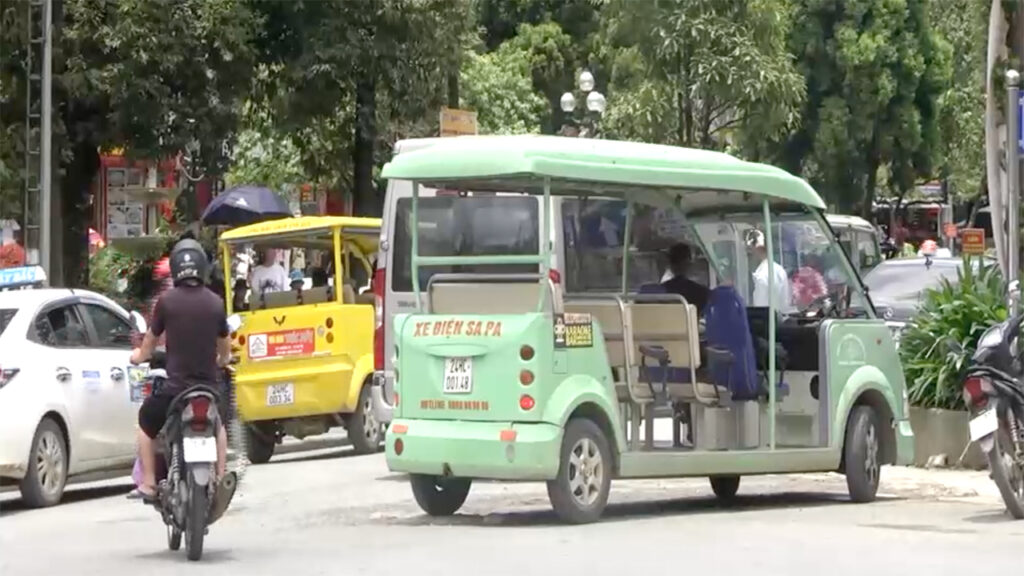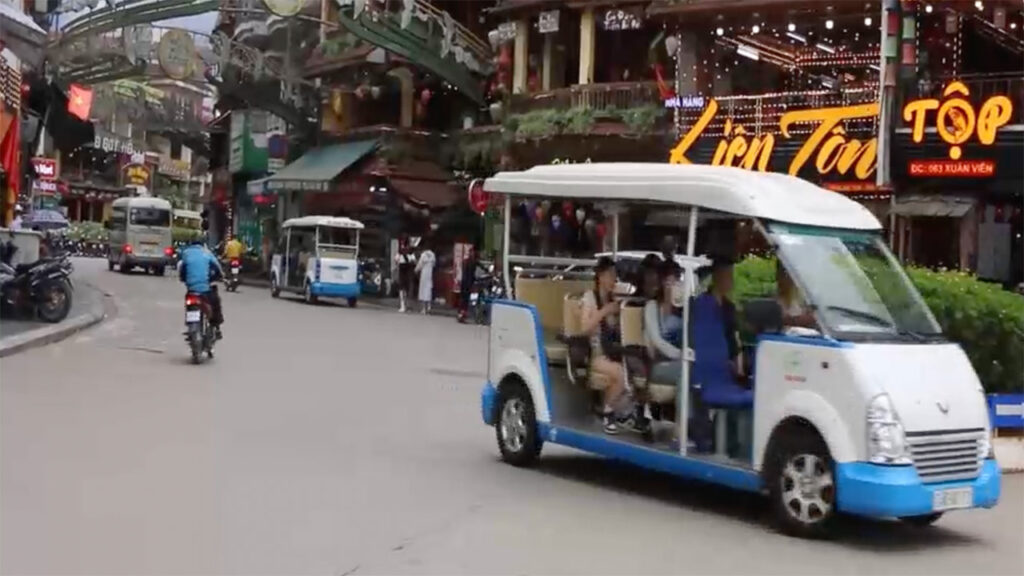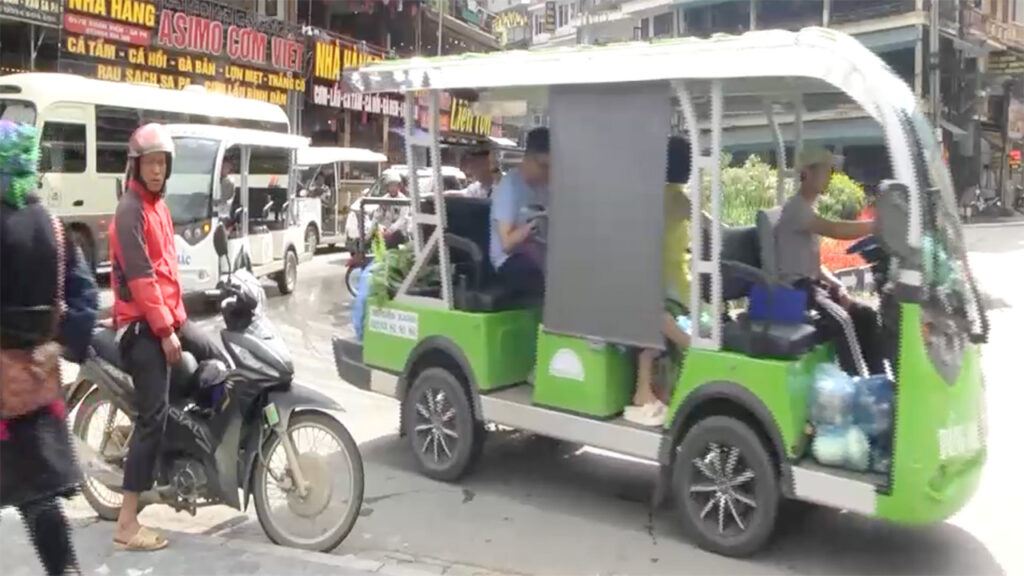Sapa Town, located in northwestern Vietnam, is renowned for its awe-inspiring views, cultural experiences, and bustling local markets. The town’s unique geographical location nestled under the shadow of the majestic Mount Fansipan provides tourists with beautiful panoramic views of nature, making Sapa Town a highly sought-after tourist destination and a retreat from the urban jungle.
As Sapa Town aspires to build its reputation as a sustainable tourist destination, one of the most significant challenges is the increasing use of private vehicles, which is mostly driven by the growing number of visitors to the town. These vehicles rely heavily on fossil fuels, resulting in increased air pollution and exacerbating the effects of climate change. Air pollution also disrupts the delicate ecosystem and natural tranquillity of the region. As Mr. Do Van Tan, the Vice Chairman of the Sapa Town People Committee, stated:
“In recent years, Sapa has been affected by climate change, which increases the level of natural disaster risks such as storms and heavy rain that cause floods, flash floods, and landslides. Moreover, the occurrence of extreme weather has become more frequent, with intensifying heat during the months of June to August, as well as periods of damaging cold.
From 2017 to 2021, [the natural disasters have caused] damage and effects on 3,101 houses; more than 287 hectares of rice, maize, crops were damaged […] 2,190 cattle and poultry were swept away; more than 120 traffic routes were eroded and damaged, and many schools, cultural houses, irrigation, domestic water supply were severely damaged. The total estimated value of property damage was about 118,039,078 billion VND [the equivalent of 5,000 billion USD].
These climate-related hazards have had major adverse effects on the community of Sapa.”
Nevertheless, Sapa Town refuses to let these challenges hinder its progress in creating a brighter future. According to Mr. Do Van Tan, the town has taken proactive measures to address these climate-related hurdles.
“With the scope of socio-economic development—especially the scope of tourism—it is necessary to develop a climate change response plan for the town, contributing to the development of Sapa towards a green, low-carbon economy.”
 Sapa Town’s ambitious plan includes the development of a green, electric tram system as a game cahnger towards revolutionising public transportation and tourism. By using to renewable energy, the electric tram not only offers efficient and eco-friendly transportation but also enhances safety, reduces congestion, and improves the overall experience for both tourists and the local community of Sapa Town. This would not only mitigate climate challenges and risks, but also elevate the town’s reputation as a green and sustainable tourist destination. The focus on sustainable mobility is part of Sapa Town’s comprehensive climate action strategy, and is a core part of developing cost-effective and sustainable use of energy in everyday life for the people of Sapa Town. Due to its significant impact on the town’s environmental footprint, transportation is given particular emphasis. By reducing dependency on fossil fuels and transitioning to renewable energy, Sapa Town’s electric tram system will not only align with the town’s sustainability goals but also enhance transport safety and accessibility in the challenging mountainous terrain of the region.
Sapa Town’s ambitious plan includes the development of a green, electric tram system as a game cahnger towards revolutionising public transportation and tourism. By using to renewable energy, the electric tram not only offers efficient and eco-friendly transportation but also enhances safety, reduces congestion, and improves the overall experience for both tourists and the local community of Sapa Town. This would not only mitigate climate challenges and risks, but also elevate the town’s reputation as a green and sustainable tourist destination. The focus on sustainable mobility is part of Sapa Town’s comprehensive climate action strategy, and is a core part of developing cost-effective and sustainable use of energy in everyday life for the people of Sapa Town. Due to its significant impact on the town’s environmental footprint, transportation is given particular emphasis. By reducing dependency on fossil fuels and transitioning to renewable energy, Sapa Town’s electric tram system will not only align with the town’s sustainability goals but also enhance transport safety and accessibility in the challenging mountainous terrain of the region.
Prior to this electric tram initiative, the town had frequent congestion and increased carbon emissions, particularly during peak hours throughout the week and festive seasons throughout the year. These issues negatively affected the overall living conditions of the area, as told by Mr. Nguyen Quang Thanh, a citizen of Sapa Town:
“Before the green tram project was put into operation, the inner city of Sapa was often clogged on weekends and holidays due to a large number of personal cars and tourist cars coming to Sapa. This makes the atmosphere much hotter and uncomfortable due to the higher emissions.”
 As such, Sapa Town is making significant investments in developing the essential infrastructure of the electric tram system. This includes creating dedicated tram lanes, the establishment of well-equipped tram stations, and convenient parking facilities, all designed to support the seamless operation of the electric tram system. To ensure effective implementation, the town is also enforcing important regulations related to urban planning, land use, and transportation integration, all aligned with the overarching goal of promoting sustainable mobility. To generate widespread awareness and foster community engagement, Sapa Town has also launched informative campaigns and integrated marketing efforts aimed at educating the public about the benefits of green mobility and encouraging active participation from all stakeholders. Residents were also consulted through public hearings held by town leaders and, as the project began its operation, people were frequently asked for their comments to improve the quality and management of the electric tram system. All of this was possible through crucial collaboration between various organisations, as mentioned by Mr. Trieu Thiet Nghia, the Vice Head of Sapa Town’s Department of Economics:
As such, Sapa Town is making significant investments in developing the essential infrastructure of the electric tram system. This includes creating dedicated tram lanes, the establishment of well-equipped tram stations, and convenient parking facilities, all designed to support the seamless operation of the electric tram system. To ensure effective implementation, the town is also enforcing important regulations related to urban planning, land use, and transportation integration, all aligned with the overarching goal of promoting sustainable mobility. To generate widespread awareness and foster community engagement, Sapa Town has also launched informative campaigns and integrated marketing efforts aimed at educating the public about the benefits of green mobility and encouraging active participation from all stakeholders. Residents were also consulted through public hearings held by town leaders and, as the project began its operation, people were frequently asked for their comments to improve the quality and management of the electric tram system. All of this was possible through crucial collaboration between various organisations, as mentioned by Mr. Trieu Thiet Nghia, the Vice Head of Sapa Town’s Department of Economics:
“In the process of building, implementing and operating the [electric tram] project, Sapa has received great support from the Global Network of Mayors on Climate & Energy (GCoM); Vietnam Cities Association, Climate Change Department – Ministry of Natural Resources and Environment; urban areas such as Nam Dinh, Hue, Cao Lanh, and agencies and departments of the province.”
Additionally, Mr. Do Van Tan also highlighted Sapa Town’s membership in GCoM as a valuable opportunity to gain fresh insights and expertise in greenhouse gas inventory data, assess climate vulnerability risks, and establish targets for emission reduction and adaptation for the town.
 Sapa Town is unwavering in its commitment to establishing a sustainable transport system that benefits both the environment and the community it serves by using a holistic approach. Sapa Town’s electric tram system is a major step taken along its transformative journey towards achieving net-zero by 2050. By 2025, Sapa Town aims to have 150 electric trams seamlessly integrated into its transportation network, with strategically designed routes that connect vital destinations such as Sapa Town Center, Mount Fansipan, Hoang Lien Son National Park, and Sapa Market.
Sapa Town is unwavering in its commitment to establishing a sustainable transport system that benefits both the environment and the community it serves by using a holistic approach. Sapa Town’s electric tram system is a major step taken along its transformative journey towards achieving net-zero by 2050. By 2025, Sapa Town aims to have 150 electric trams seamlessly integrated into its transportation network, with strategically designed routes that connect vital destinations such as Sapa Town Center, Mount Fansipan, Hoang Lien Son National Park, and Sapa Market.
The town significantly reduces greenhouse gas emissions from private cars, motorbikes, and buses by transitioning from fossil fuels to clean energy and implementing efficient tram routes. It is hoped that Sapa Town’s sustainable transportation programs will benefit many generations to come. This commitment to sustainability will not only contribute to the global fight against climate change, but also position Sapa Town as a leading eco-friendly tourist destination, with increased accessibility and convenience for a diverse range of individuals, including seniors, children, pregnant women, disabled tourists, and ethnic minority communities, who may face challenges navigating hilly terrains. Sapa Town opens the way for a greener, more accessible future for all by emphasising inclusion and ease of movement.
—
Written by: Jessica Narikit Bangun
Reviewed by: Asih Budiati




